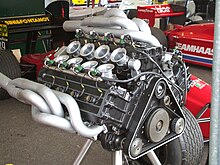W12 engine

A W12 engine is a twelve-cylinder piston engine which uses a W configuration.
W12 engines with three banks of four cylinders were used by several aircraft engines from 1917 until the 1930s. A three-bank design was also used for an unsuccessful W12 engine which was intended to compete in Formula One in 1990.
Although less commonly used in automobiles than V12 engines, a W12 petrol engine has been produced by Volkswagen Group since 2001. This four-bank engine – based on two VR6 engines with a common crankshaft – has been used in various cars sold under the Audi, Bentley and Volkswagen brands.
Aircraft engines[]
The Napier Lion was a three-bank design (also called "broad arrow" design) W12 engine produced in the United Kingdom from 1917 to the late 1930s. It had a capacity of 24 litres (1,465 cu in) and produced 336–671 kW (450–900 hp). As well as use in various military and racing airplanes, the Lion was also used in land speed record cars (such as the Napier-Railton and the Napier-Campbell Blue Bird) and racing boats (such as the Miss Britain III).
During the 1920s, the Farman 12We aircraft engine was produced in France. The 12We produced 500 hp (373 kW) and was one of the company's best selling engines in the 1920s.
The Lorraine 12E Courlis is another W12 aircraft engine that was produced in France during the 1920s and 1930s.
Motor racing engines[]

For the 1990 Formula One season, the Italian team Life Racing Engines built a three-bank W12 engine with a displacement of 3.5 L (214 cu in). The Life Racing Engine F35 used a central master connecting rod, with a slave rod locating onto each side of the master rod, rather than directly onto the crank pin. This meant that there was no offset between the cylinders, reducing the length of the crankpins.[1] The engine was used in rounds 1 to 12 of the 1990 season, however it was unreliable and lacking in power, and the car failed to pre-qualify for any races.[1][2][self-published source] The W12 engine was replaced by a third-party V8 engine after round 12.[2]
Road car engines[]

The only mass-production W12 engine is the Volkswagen 6.0 WR12 48v, a four-bank design which was released in 2001. This engine has been used in several models from the brands Audi, Bentley and Volkswagen, and in 2003 a turbocharged version was released.
The engine is constructed by mating two narrow-angle 15° VR6 engines at an inclined angle of 72°. The narrow angle of each set of cylinders allows just two overhead camshafts to drive each pair of banks, so the W12 engine has the same number of camshafts as a V12 engine. The W12 engine has a very compact design for a 12-cylinder engine, with the overall size of the 6.0 L (366 cu in) engine being smaller than Volkswagen's contemporary 4.2 L (256 cu in) V8 engine.[3]
The first application of the Volkswagen W12 was the 2001 Volkswagen W12, a mid-engined concept car which set the 24‑hour world endurance record in 2001 with a distance of 7,085.7 kilometres (4,402.8 mi) and an average speed of 295 km/h (183 mph). The first production car to use the W12 engine was the 2001 Audi A8 (D2).[4] Other cars to use the W12 engine are the 2003–present Bentley Continental GT, 2005-present Bentley Continental Flying Spur,[5][6] 2015–present Bentley Bentayga, 2004-2011 Volkswagen Phaeton W12[7] and the 2005-2010 Volkswagen Touareg W12. The engine was also used in the 2006 Spyker C12 La Turbie and 2008 Spyker C12 Zagato low-volume sports cars.
References[]
- ^ a b Ludvigsen, Karl (2005). The V12 Engine. Sparkford, Yeovil: Haynes Publishing. pp. 356–358. ISBN 1-84425-004-0.
- ^ a b Teaters, Matthew (2011). "1990 Life Racing Engines". Formula One Famous Failures. Trafford Publishing. ISBN 978-1-4251-8528-2. Retrieved 2013-12-17.
Best Result: 32nd fastest in Pre-Qualifying (Giacomelli, Imola)
- ^ "2005 Audi A8 Review and Photos". New Car Test Drive. Retrieved 2011-12-06.
- ^ "Audi A8L details". WorldCarFans.com. Audi of America. 2004-01-12. Archived from the original on 2013-07-30. Retrieved 2009-08-26.
- ^ "Continental Flying Spur specification". BentleyMotors.com. Bentley Motors Limited. Retrieved 2 September 2009.
- ^ "Continental Flying Spur Speed specification". BentleyMotors.com. Bentley Motors Limited. Retrieved 2 September 2009.
- ^ "Volkswagen Phaeton - in depth". WorldCarFans.com. Volkswagen AG. 2002-03-01. Archived from the original on 2013-04-23. Retrieved 2009-08-26.
| Wikimedia Commons has media related to W12 engines. |
- Piston engine configurations
- W engines